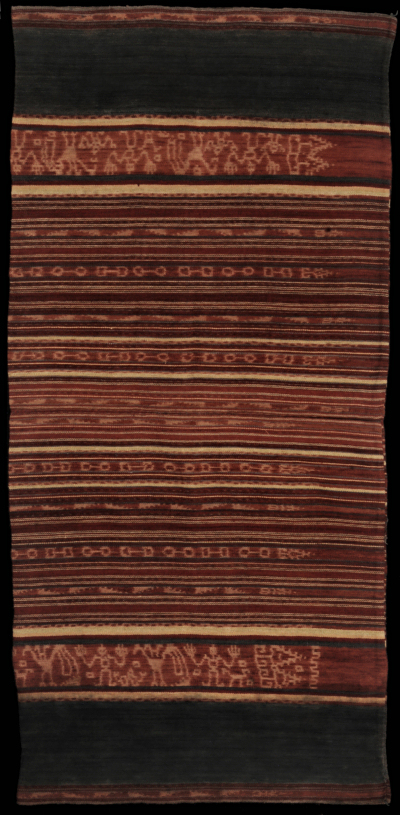| |
 
 | | | |
102 Moluccas, Kisar
Homnon (sarong)  
| | Locale: | Probably Oirata people. | | Period: | 19th c. to very early 20th | | Yarn: | Cotton, hand-spun, medium | | Technique: | Warp ikat | | Panels: | 2 | | Size: | 58 x 122 cm (1' 10" x 4' 0") LW: 2.10 | | Weight: | 485 g (17.1 oz), 343 g/m2 (1.12 oz/ft2) | | Design: | Rimanu motif, reserved for aristocracy. Narrow horizontal bands with small squares and circles in brick red, two wider bands in solid indigo and two wider bands with rimanu motif: human figures standing with raised hands, birds (probably cocks, manu), and horses, ending in the base-mounted tumpal that is used throughout the southern Moluccas. Eight stripes decorated with right scalene triangles that are shared with Tanimbar, where they are called 'flags'. | | Comment: | Old piece in excellent condition, with what Fraser-Lu calls 'delightfully naive pictorial motifs in the form of human figures with huge outspread hands'. Note that on this cloth, unlike on PC 101 and 103, the raised hands have only four fingers. | | Background: | Chapters on Moluccas and Kisar. | | Exhibited: | Museu do Oriente, Lisbon, 2014/15 | | Published: |
Woven Languages, 2014.
Ikat Textiles of the Indonesian Archipelago, 2018.
| | Compare: | 101 103 138 091 275 | | Sources: | Very similar to 19th C. homnon in Granucci, Art of the Lesser Sundas, Fig. 107. Very similar to sarong in Khan Majlis, Woven Messages, Fig 311, similar to one on Fig. 310. Similar cloth in Tropenmuseum, Tillman collection. Also very similar to Pusaka Collection Nr. 101, 103 and 134. | | |

©Peter ten Hoopen, 2025
All rights reserved.
|
|


